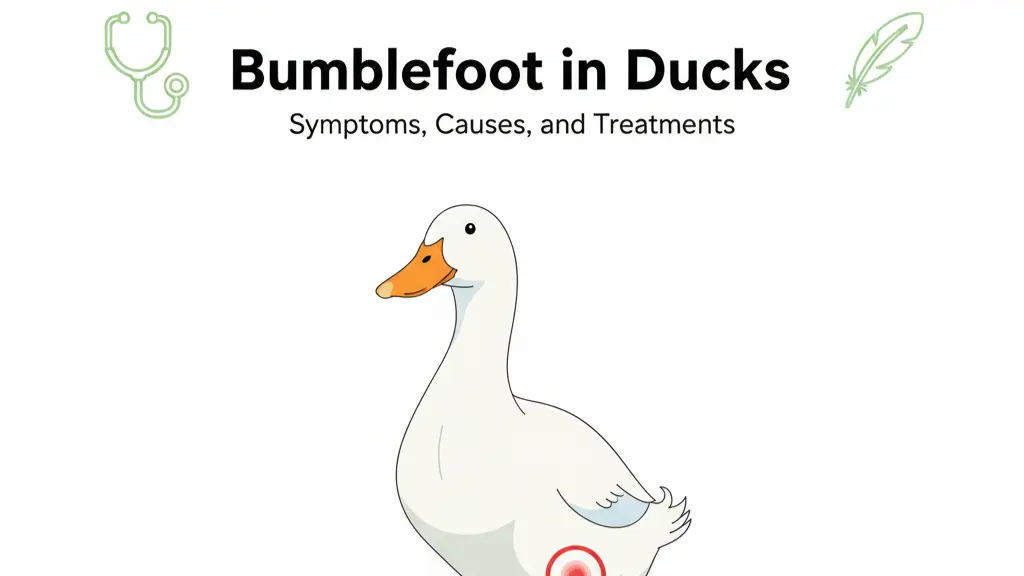If you’ve ever noticed your duck limping, sitting more often, or avoiding the pond, your brain probably jumped to panic mode: What’s wrong with my duck?
Sometimes, it’s something small like a tender footpad from rough pebbles or dirty bedding.
Other times, it’s bumblefoot in ducks—an infection that can become serious if ignored.
I’ve had to deal with this firsthand in my own flock. That ugly black scab, the swelling, the reluctant gait—it’s not something you forget. The good news? With the right mix of care, prevention, and treatment, ducks bounce back.
Let’s break down what bumblefoot actually is, how it happens, what symptoms you’ll notice, and the step-by-step treatments that actually work.
What Is Bumblefoot in Ducks?
Bumblefoot (medical term: pododermatitis) is basically an abscess or ulceration on a duck’s footpad.
It starts as a small lesion from trauma, pressure, or bacteria exposure, then escalates to infection.
If untreated, the infection can spread deeper—into the tendon sheath, cartilage, fascia, and even bones—leading to chronic pain, deformity, or even septicemia.
Think of it like this: cracked heels in humans but on steroids.
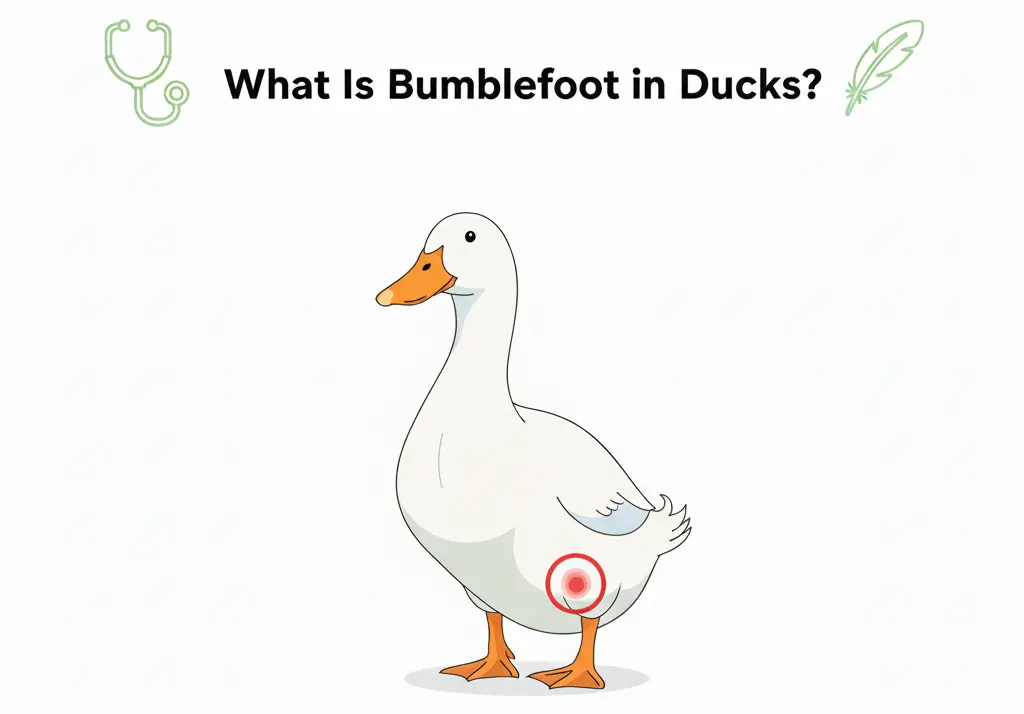
Symptoms of Bumblefoot in Ducks
So how do you know when your duck has it? Here’s what I’ve seen and what most owners report:
- Limping / reluctance to move—classic first sign.
- Redness, swelling, or soreness in the footpad.
- Black scab or necrotic plug right on the dorsal pad.
- Reduced activity or fatigue compared to the flock.
- Reluctance to swim or perch, preferring to sit on straw mats.
- Loss of appetite and dullness, especially in advanced cases.
- Warmth / tenderness when you touch the foot.
Some ducks show subtle signs like mild depression or feather damage from sitting too much. In severe cases, you may see pus drainage or flaking skin around the lesion.
Key takeaway: Early symptoms can look like a small sore. By the time you see a black scab or swelling, it’s more advanced.
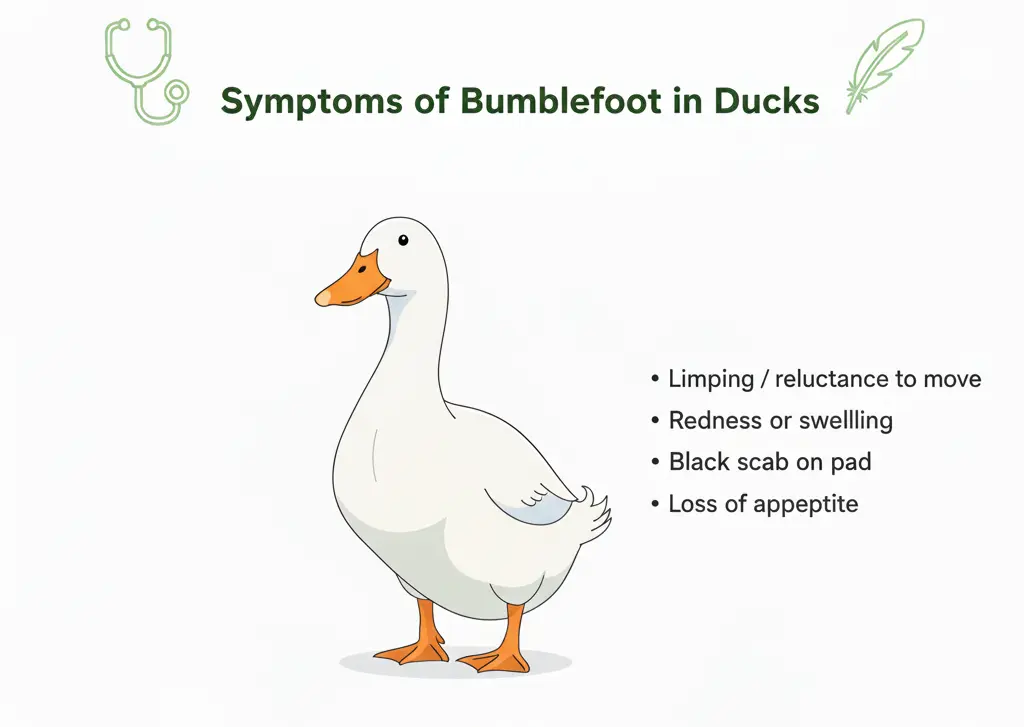
Causes of Bumblefoot in Ducks
From years of duck-keeping (and mistakes), I can tell you—bumblefoot isn’t random. It’s usually tied to daily environment, diet, and surface pressure.
1. Rough or Improper Flooring
- Hard concrete, rough wood, sharp pebbles, or dirty mats cut into the footpad.
- Artificial turf, rubber mats, or concrete runs with poor sanitation are classic culprits.
2. Contaminated and Moist Conditions
- Mud, feces buildup, and poor bedding hygiene cause bacterial growth.
- Opportunistic bacteria like Staphylococcus aureus (sometimes methicillin-resistant) invade even tiny entry wounds.
3. Trauma & Stress
- Splinters, sharp sticks, or even chasing and mating-season injuries.
- Heavy breeds with extra weight = higher podiatric stress.
4. Poor Nutrition & Deficiencies
- Vitamin A deficiency, protein deficiency, or obesity weaken the immune system.
- Malnutrition slows wound healing and increases infection risk.
5. Water & Environmental Issues
- Overexposure to muddy ponds, chlorine-contaminated troughs, or unsanitary water sources weakens the skin barrier.
- Constant moisture softens the footpad and makes it prone to cracks.
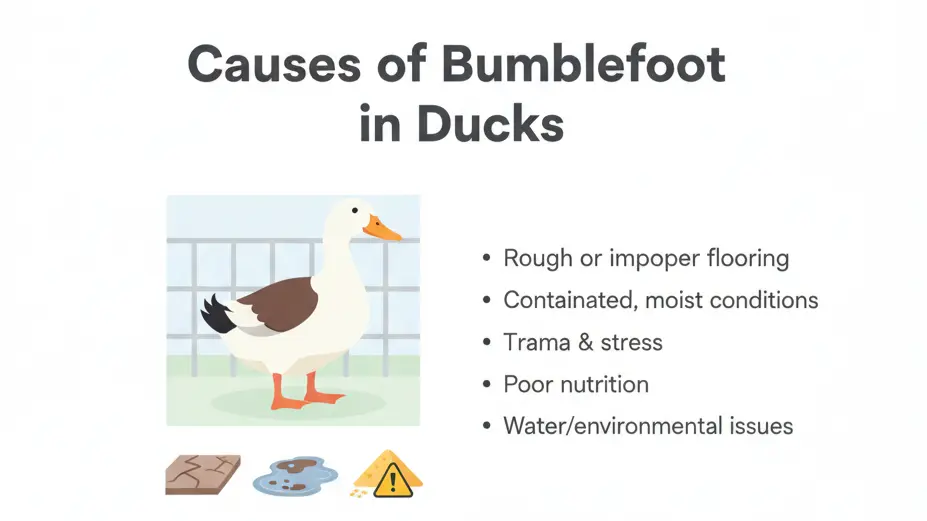
Step-by-Step Treatment for Bumblefoot in Ducks
Here’s the strategy I’ve used for both mild cases and advanced infections.
Step 1: Physical Exam & Diagnosis
- Check for clinical signs: swelling, tenderness, black scab, pus plug.
- A vet may run radiographs, histology, or bacteria culture if it’s advanced.
- Identify whether it’s mild surface infection or deep tissue/osteomyelitis.
Step 2: Cleaning & Warm Soak
- Soak the foot in Epsom salt warm water for 10–15 minutes.
- This softens the scab and improves circulation.
- Keep the duck calm; I use a small pool or soaking tub.
Step 3: Debridement (if necrotic plug is visible)
- Carefully lift/remove the scab or fibrous plug with a sterile scalpel or tweezers.
- Drain pus, clot material, or necrotic tissue.
- Irrigate the wound using saline, betadine solution, or irrigation fluid.
(If you’re not confident here, leave it for a vet. Cutting too deep can damage fascia and tendon.)
Step 4: Antimicrobial / Topical Applications
- Apply antimicrobial ointments, silver sulfadiazine, or medical honey for wound protection.
- Some vets now recommend photodynamic therapy and topical sprays for resistant bacteria.
Step 5: Bandaging & Foot Protection
- Wrap with a sterile gauze pad + vet wrap to protect.
- Use a duck bootie / orthopedic boot / cushioned donut to reduce pressure.
- Change dressing daily, keeping moisture out.
Step 6: Medication (Veterinary Guided)
- Systemic antibiotics (oral or intravenous) for advanced cases.
- Pain management with anti-inflammatories.
- Supportive therapies like acupuncture or phototherapy in certain clinics.
Step 7: Supportive Care & Environment Modifications
- Rest isolation pen with soft bedding, straw, or mats.
- Keep surfaces clean, dry, atraumatic.
- Nutritional therapy (greens, protein, vitamin supplementation).
- Monitor stools and appetite for weakness or anorexia.
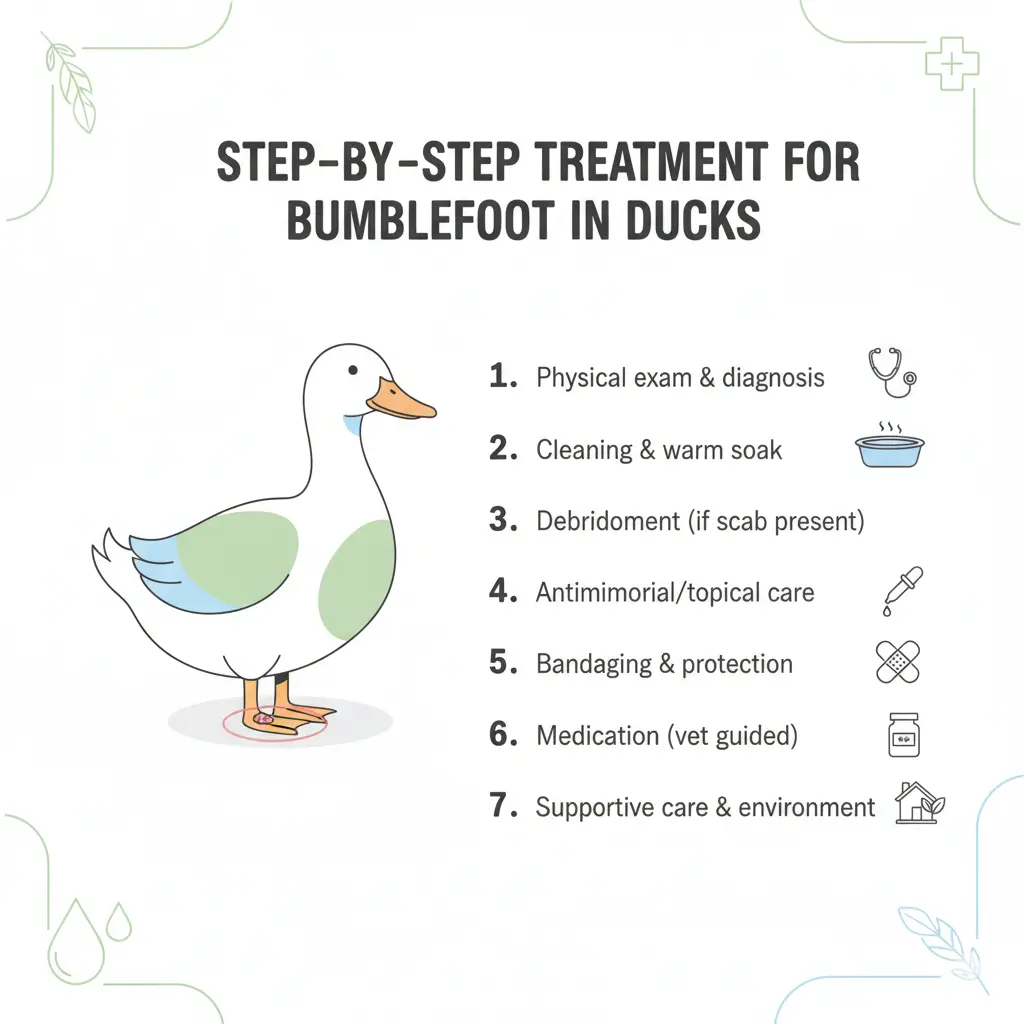
Prevention: Keeping Bumblefoot Away
Here’s the truth: prevention is 100x easier than treatment.
- Clean, dry bedding: Pine shavings, hemp bedding, or straw—changed often.
- Soft perching & surfaces: Replace concrete, rough floors, and splintered ramps.
- Pond hygiene: Well-drained runs, avoid mud contamination.
- Diet balance: Protein, greens, vitamin supplementation, no obesity.
- Routine foot checks: Look for abrasions, lesions, early signs weekly.
- Sanitation: Coop cleaning, disinfectants, and dry litter management.
I also rotate terrain—grass, sand, cushioned mats—so feet don’t take repetitive stress.
Recovery Timeline of Bumblefoot
- Mild case: 1–2 weeks with soaks, dressing, antibiotics if needed.
- Advanced case: 4–6 weeks, possibly surgery and long-term bandaging.
- Chronic infection: Requires deeper vet intervention (sutures, debridement, or even orthopedic surgery).
Pro tip: Document healing with photos every few days. Spotting improvement (or lack of it) helps adjust care.
My Personal Experience with Recovery
One of my Pekins couldn’t walk without a painful limp. X-rays showed osteomyelitis (bone infection).
Treatment included surgery, intravenous regional perfusion therapy, long-term antibiotics, and daily wound care.
It was intense. But once she was placed in a clean recovery enclosure with cushioned mats, balanced diet, and consistent bandaging, she bounced back. Today, she waddles without pain.
Ducks are surprisingly resilient if we give them the right support.
Conclusion
Bumblefoot in ducks is a preventable pain that sneaks up if you’re not paying attention.
It starts small—just a sore or tiny scab—but can spiral into infection, swelling, sepsis, and even loss of mobility.
With good prevention (clean bedding, proper diet, soft surfaces), you’ll avoid most cases.
If your duck does get it, quick treatment—warm soaks, wound cleaning, bandage protection, and vet-guided antibiotics—can save their life and restore full mobility.
Take care of their feet, and your ducks will take care of you with years of happy waddling.
FAQs on Bumblefoot in Ducks
How can I tell if my duck has bumblefoot or just a sore?
A sore looks like redness or small abrasion. Bumblefoot usually has swelling, tenderness, and that distinct dark scab in the center.
Can a duck recover from bumblefoot naturally?
Mild lesions can heal with supportive care, but moderate/advanced cases need active treatment (soaks, debridement, antibiotics).
Can bumblefoot in ducks heal on its own?
A very mild case with just a little redness might resolve if you immediately fix the environmental cause (e.g., add soft bedding). However, once an ulcer or scab forms, it’s an active infection that requires treatment. It will not heal on its own and will only get worse, potentially leading to septicemia and death.
Is the pus in bumblefoot contagious to other ducks?
The bacteria causing bumblefoot, usually Staphylococcus aureus, is everywhere in the environment. While the pus itself is full of bacteria, the condition isn’t “contagious” in the way a virus is. However, if your coop conditions caused one case, it’s highly likely other ducks are at risk. It’s a sign you need to evaluate your flock’s environment control and hygiene.
Is bumblefoot contagious in ducks?
Not directly. But poor sanitation spreads opportunistic bacteria through the flock environment, so proper hygiene is crucial.
How do you make a protective duck bootie?
A simple DIY duck bootie can be made from a piece of a pool noodle or pipe insulation foam. Cut a piece to the shape of the footpad, then cut a hole in the center for the lesion to sit in (like a donut). Place this “cushion” on the foot and secure it with vet wrap, wrapping in a figure-eight pattern around the ankle and foot. Ensure it’s not too tight!
What happens if bumblefoot is left untreated?
It can spread into fascia, tendons, cartilage, and bones—causing chronic pain, arthritis, or even septicemia. Mortality is a real risk in advanced cases.
What’s the difference between bumblefoot in ducks and chickens?
The causes and treatment are very similar. The main difference is anatomical. Ducks have webbed feet, which can make bandaging a bit trickier. You have to be careful not to wrap the toes together or restrict the natural movement of the webbing. The principles of cleaning, debridement, and pressure relief are the same for both poultry species.
What’s the best bedding to prevent bumblefoot?
Soft, dry bedding like straw, hemp, or pine shavings is safest. Avoid rough concrete or moisture-logged mats.
References & Credible Sources
- https://www.merckvetmanual.com
- https://www.sciencedirect.com/topics/veterinary-science-and-veterinary-medicine/pododermatitis
- https://poultry.extension.org
- https://www.avma.org/resources-tools
- https://pubmed.ncbi.nlm.nih.gov
Hello! I’m Ibrahim, the owner and writer of this blog. I run a chicken farm with 160 chickens, and I’ve gained a lot of knowledge about raising and caring for them. Now, I want to share my insights and experiences with you to help you in chicken keeping.

